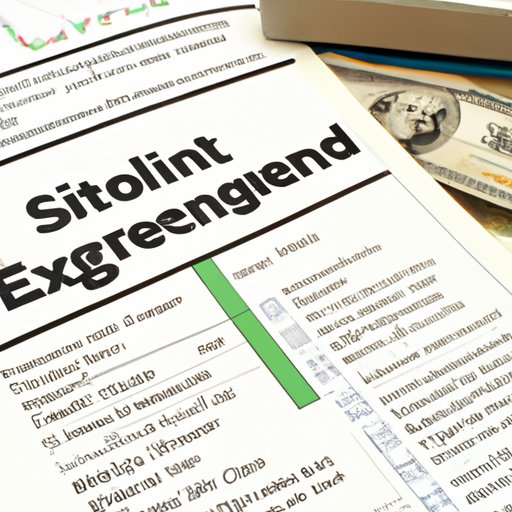Introduction
Investing money is one of the best ways to ensure long-term financial security. But with so many different methods of investing, it can be difficult to know where to invest money safely. In this article, we’ll explore different types of investments and the associated risks in order to help you make an informed decision about where to invest your money.

Investing in Stocks and Bonds
Investing in stocks and bonds is one of the most popular ways to invest money. Stocks represent ownership in a company and are typically bought and sold on stock exchanges. Bonds, on the other hand, are debt instruments that pay interest to the bondholder. Both stocks and bonds offer the potential for growth, though there is always some degree of risk involved.
Advantages of Investing in Stocks and Bonds
The main advantage of investing in stocks and bonds is the potential for strong returns. Stocks often pay dividends, which are payments made to stockholders based on the company’s profits. Bonds also provide steady income through interest payments. Additionally, it is relatively easy to buy and sell stocks and bonds through online brokers.
Disadvantages of Investing in Stocks and Bonds
The main disadvantage of investing in stocks and bonds is the risk involved. The value of stocks and bonds can fluctuate, and there is no guarantee of a return. Additionally, stock prices can be volatile, meaning they can change rapidly over short periods of time.
Risks Involved in Investing in Stocks and Bonds
The biggest risk involved in investing in stocks and bonds is the potential for losses. Stock prices can go up or down depending on market conditions, and bonds can lose value if interest rates rise. Additionally, companies can go bankrupt, which means that the value of their stock may become worthless. It is important to research the companies you are considering investing in and to diversify your portfolio to minimize risk.
Investing in Mutual Funds
Mutual funds are investment vehicles that pool the money of multiple investors and invest it in a variety of stocks, bonds, and other securities. Mutual funds offer the benefit of diversification, as the fund manager is responsible for selecting the investments and managing the portfolio. This makes it easier for investors to manage their money without having to do all the research themselves.
Advantages of Investing in Mutual Funds
The main advantage of investing in mutual funds is the potential for growth. Because the fund manager is responsible for selecting the investments, they can choose stocks and bonds that have the potential for higher returns. Additionally, because the money is pooled together, investors can benefit from economies of scale and lower fees than they would pay for individual stocks and bonds.
Disadvantages of Investing in Mutual Funds
The main disadvantage of investing in mutual funds is the lack of control over the investments. Investors must trust the decisions of the fund manager, and there is no guarantee of a return. Additionally, mutual funds charge management fees, which can reduce overall returns.
Risks Involved in Investing in Mutual Funds
The main risk involved in investing in mutual funds is the potential for losses. As with any type of investment, the value of mutual funds can go up or down depending on market conditions. Additionally, the fund manager may make poor investment decisions, which can lead to losses.

Investing in U.S. Treasury Securities
U.S. Treasury securities are debt obligations issued by the U.S. government. These include Treasury bills, notes, and bonds, which all pay periodic interest payments to the investor. Treasury securities are considered to be one of the safest investments available, as they are backed by the full faith and credit of the U.S. government.
Advantages of Investing in U.S. Treasury Securities
The main advantage of investing in U.S. Treasury securities is the safety. The U.S. government guarantees these investments, so investors can rest assured that their money is safe. Additionally, Treasury securities are exempt from state and local taxes, making them an attractive option for those looking to minimize their tax liability.
Disadvantages of Investing in U.S. Treasury Securities
The main disadvantage of investing in U.S. Treasury securities is the low rate of return. While these investments are considered to be safe, they typically pay lower interest rates than other types of investments. Additionally, the value of the investment may decrease if interest rates rise.
Risks Involved in Investing in U.S. Treasury Securities
The main risk involved in investing in U.S. Treasury securities is inflation. Although these investments are considered to be safe, their value can decrease if inflation rises faster than the interest rate paid on the security. Additionally, the value of the investment may decrease if interest rates rise.
Investing in Certificates of Deposit (CDs)
Certificates of deposit (CDs) are bank deposits that pay a fixed rate of interest for a specified period of time. CDs are insured by the FDIC, making them a safer option than investing in stocks and bonds. Additionally, CDs allow investors to lock in a rate of return, which can be beneficial in times of market volatility.
Advantages of Investing in CDs
The main advantage of investing in CDs is the safety. CDs are insured by the FDIC, so investors can rest assured that their money is safe. Additionally, CDs offer the benefit of locking in a rate of return, which can be advantageous in times of market volatility.
Disadvantages of Investing in CDs
The main disadvantage of investing in CDs is the low rate of return. CDs typically pay lower interest rates than other types of investments, such as stocks and bonds. Additionally, the money is locked in for a certain period of time, so investors cannot access it until the CD matures.
Risks Involved in Investing in CDs
The main risk involved in investing in CDs is the potential for losses. While CDs are insured by the FDIC, the value of the investment can still decrease if interest rates rise. Additionally, if the bank fails, the investor may not receive the full amount of their deposit.
Investing in High-Yield Savings Accounts
High-yield savings accounts are savings accounts offered by banks and other financial institutions that pay higher interest rates than traditional savings accounts. These accounts are FDIC insured, making them a safer option than investing in stocks and bonds. Additionally, high-yield savings accounts offer the convenience of easy access to funds.
Advantages of Investing in High-Yield Savings Accounts
The main advantage of investing in high-yield savings accounts is the safety. These accounts are FDIC insured, so investors can rest assured that their money is safe. Additionally, high-yield savings accounts offer the convenience of easy access to funds, allowing investors to withdraw money when needed.
Disadvantages of Investing in High-Yield Savings Accounts
The main disadvantage of investing in high-yield savings accounts is the low rate of return. These accounts typically pay lower interest rates than other types of investments, such as stocks and bonds. Additionally, the money is not locked in, so investors may be tempted to withdraw their funds before they have had a chance to fully appreciate.
Risks Involved in Investing in High-Yield Savings Accounts
The main risk involved in investing in high-yield savings accounts is the potential for losses. While these accounts are FDIC insured, the value of the investment can still decrease if interest rates rise. Additionally, the bank may fail, which could mean that the investor does not receive the full amount of their deposit.
Investing in Real Estate Investment Trusts (REITs)
Real estate investment trusts (REITs) are publicly traded companies that own and operate real estate properties. These properties can include office buildings, shopping malls, apartments, warehouses, and more. REITs generate income through rental payments and the sale of properties, and they offer the potential for strong returns.
Advantages of Investing in REITs
The main advantage of investing in REITs is the potential for strong returns. REITs generate income through rental payments, which can be substantial. Additionally, REITs are publicly traded, which makes them easy to buy and sell.
Disadvantages of Investing in REITs
The main disadvantage of investing in REITs is the risk involved. The value of REITs can fluctuate, and there is no guarantee of a return. Additionally, REITs are subject to the same risks as any other real estate investment, such as changes in the local economy or property values.
Risks Involved in Investing in REITs
The main risk involved in investing in REITs is the potential for losses. The value of REITs can go up or down depending on market conditions, and there is no guarantee of a return. Additionally, REITs are subject to the same risks as any other real estate investment, such as changes in the local economy or property values.
Investing in Gold or Other Precious Metals
Gold and other precious metals have long been viewed as a safe haven for investors. These metals are seen as a hedge against inflation and economic uncertainty, and they offer the potential for strong returns. Additionally, gold and other precious metals can be bought and sold easily through online brokers.
Advantages of Investing in Gold or Other Precious Metals
The main advantage of investing in gold and other precious metals is the potential for strong returns. Gold and other precious metals are seen as a hedge against inflation, and their prices tend to increase when the stock market is volatile. Additionally, these metals can be bought and sold easily through online brokers.
Disadvantages of Investing in Gold or Other Precious Metals
The main disadvantage of investing in gold and other precious metals is the risk involved. The value of these metals can fluctuate, and there is no guarantee of a return. Additionally, the price of gold and other precious metals is affected by supply and demand, which can be unpredictable.
Risks Involved in Investing in Gold or Other Precious Metals
The main risk involved in investing in gold and other precious metals is the potential for losses. The value of these metals can go up or down depending on market conditions, and there is no guarantee of a return. Additionally, the price of gold and other precious metals is affected by supply and demand, which can be unpredictable.
Conclusion
Investing money is one of the best ways to ensure long-term financial security. There are many different types of investments, each with their own advantages and risks. Stocks and bonds offer the potential for growth, while U.S. Treasury securities and CDs provide safety. Mutual funds, high-yield savings accounts, REITs, and gold and other precious metals offer a combination of safety and potential returns. When choosing where to invest money safely, it is important to consider your own goals and risk tolerance. By doing your research and diversifying your investments, you can maximize your returns and ensure a secure financial future.
(Note: Is this article not meeting your expectations? Do you have knowledge or insights to share? Unlock new opportunities and expand your reach by joining our authors team. Click Registration to join us and share your expertise with our readers.)
